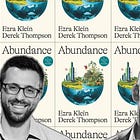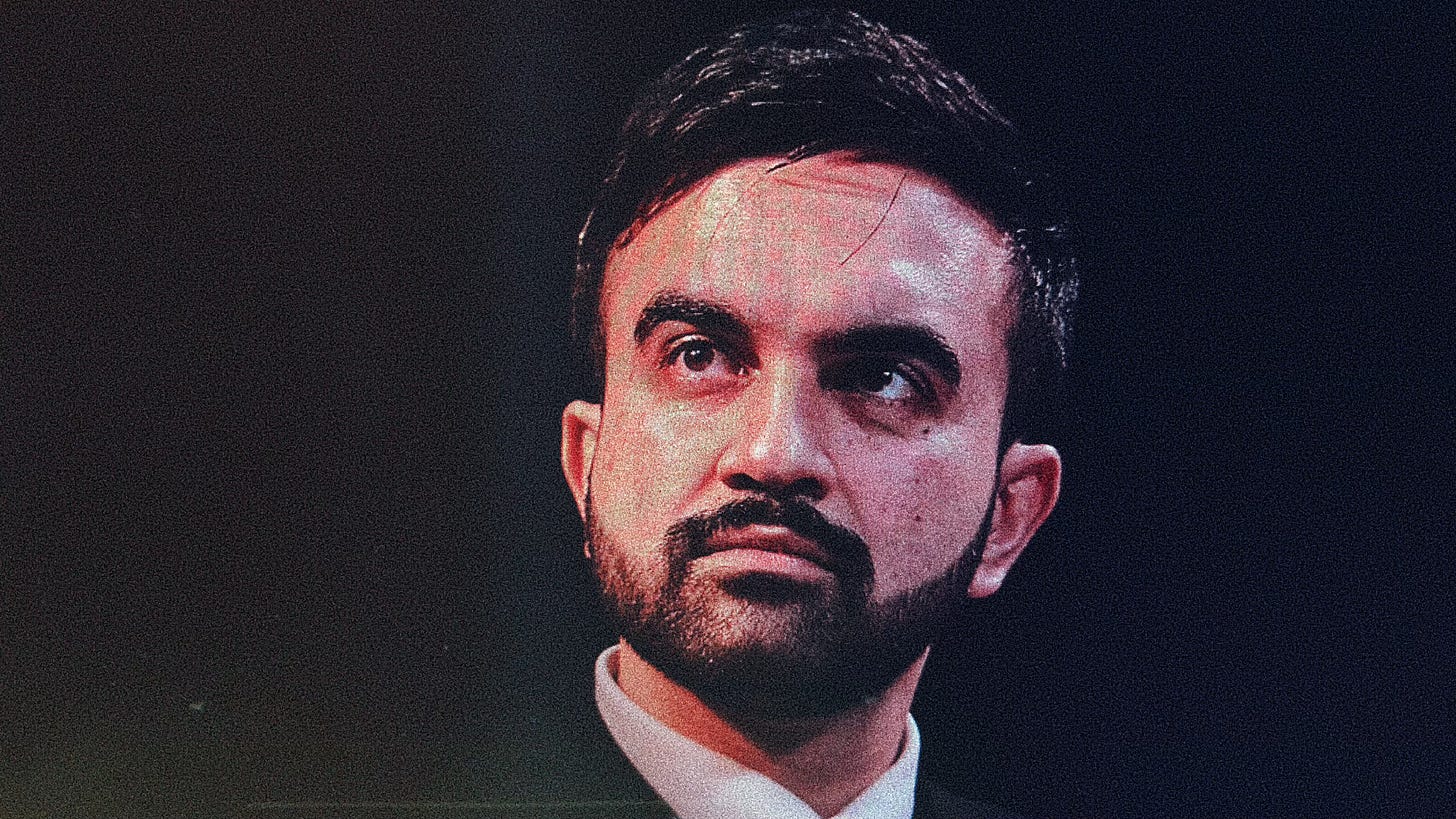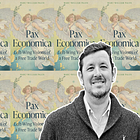Will Mamdani Govern More as a Democratic Socialist or as an Abundance Liberal?
His policy evolution and the team he’s assembling suggest that he could be moving in a market-friendly direction
Last Sunday night at Forest Hills Stadium in Queens, where Frank Sinatra once played, a packed crowd of 13,000 came out to see the man leading the race to be the next mayor of New York, New York. Zohran Mamdani, the charismatic state assemblyman and Democratic mayoral nominee, was joined by Gov. Kathy Hochul, Rep. Alexandria Ocasio-Cortez, Sen. Bernie Sanders of Vermont, and dozens of other elected and union officials in a demonstration of his ascent to the pinnacle of New York politics. The cheers for the 34-year-old Mamdani exceeded those for AOC and Bernie, two New York natives who are among the most popular politicians in America. When some in attendance pestered Gov. Hochul with chants of “Tax the rich!”—Hochul has opposed raising taxes and said, “I don’t want to lose any more people to Palm Beach”—it was Mamdani who made an early appearance onstage to embrace her and endear her to the crowd.
But gestures of this sort have also endeared Mamdani to people like me, market liberals committed to the YIMBY cause, enthusiastic about the “abundance” agenda (an approach to politics that opposes artificial scarcity and advocates for a “liberalism that builds”), who seek more effective institutions and procedures—while harboring an aversion to left-populism, particularly when it eschews rational analysis. As the political director of the New York City New Liberals, a chapter of the Center for New Liberalism, I was part of a team that prepared a 2025 NYC Democratic Primary Voting Guide, which ranked candidates based on their policy proposals—not their rhetoric or ideology. Mamdani did not crack the top four.
But with days to go before the election, looking at the team he is assembling, his evolution on policy issues, and the overtures he has made to institutional and business interests, I am a bit less concerned about the prospect of Mamdani as mayor—and maybe even a tad hopeful.
True New Yorker
Mamdani has been vilified by Trump and other MAGA right-wingers as a radical Marxist who is allegedly plotting a communist revolution in New York City, and as a self-destructive and dangerous choice for the Democratic Party by those in the center. While these appraisals range from unhinged to overstated, we were troubled by the paradoxical lack of ambition and realism in his housing plan, and found that his redistribution agenda departs from sound economic policy and demonstrates limited consideration of tradeoffs and consequences.
However, Mamdani has captivated the New York masses with his aspirational vision for a government that is morally conscious, protective of multiracial and multireligious democracy, and hyper focused on the issues of greatest resonance to local residents. This last point is key: Despite making waves nationally, the way his campaign embodies the essential spirit—and the core concerns—of New Yorkers is indispensable for analyzing Mamdani’s mayoral candidacy.
Born in Uganda to parents of Indian descent—a Hindu mother, who is a celebrated, Oscar-nominated director, and a Muslim father, who is a highly regarded professor of international politics at Columbia University—he is committed to a tolerant, pluralist society at a visceral level. He studied at Bowdoin College, where he founded a chapter of Students for Justice in Palestine, and after college worked as a foreclosure prevention and housing counselor. His background as a religious and ethnic minority in every country he has lived in and his experience working on community issues deeply inform his politics and he has not shied away from any of that.
On the contrary, instead of abandoning his background to project a generic political professionalism that many public figures adopt to win office, Mamdani affirmatively leans into his experiences and influences. In an age when authenticity is prized, this has worked well for him—the mainstream Democratic strategist David Axelrod called him “a powerfully articulate, authentic exponent of change.” He parries attacks on his age and inexperience, religion and ethnicity, and alleged naivete with a warm smile and affable wit. But he can also address his identity more head-on when faced with Islamophobic attacks by his rivals, as his viral speech on his experience as a Muslim in New York City showed. Compared to his opponents, Andrew Cuomo, who resigned the governorship amid sexual harassment allegations, and Curtis Sliwa, who has been a divisive and clownish figure in New York City for decades, Mamdani is a downright decent and upright figure, qualities that no doubt appeal to New Yorkers disgusted by the rank corruption of the current mayor, Eric Adams.
The cause that has presented Mamdani with perhaps his greatest political challenge is his passionate advocacy of Palestinian rights, especially in the face of the massive suffering in Gaza. Mamdani’s perceived anti-Israel stance, including his initial refusal to disavow the phrase “globalize the intifada”—that, contrary to popular perception, he has not personally used—has alienated many New York Jews and called into question his message of inclusion. Mamdani has countered by aggressive outreach to the city’s Jewish community, the largest in the world. He gathered business leaders and assured them he would discourage the use of that phrase going forward. More significantly, he has indicated that he would welcome people who hold various perspectives on Zionism and Israel in his future administration. Although Cuomo is still the clear favorite among New York Jews, Mamdani might have gained some ground according to some polls. (Of course, nothing Mamdani has said matches the abject Islamophobia Cuomo has peddled against him; high-profile figures on the right, meanwhile, have abandoned any pretense of responsible rhetoric: Rep. Elise Stefanik of New York called him a “jihadist” and Ellie Cohanim, who served under Trump as an antisemitism monitor, used images of the 9/11 attacks, including the famous Falling Man photograph, to urge New Yorkers to vote for Cuomo.)
But Mamdani continues to fuse a religious moral language with secular liberal institutionalism, an idealistic concern for the marginalized and the economic underdogs with a commitment to empirical governance and outcome-based goals. And he channels the love of New Yorkers for their city—which makes him hyper-focused on local conditions. (As an assemblyman in 2021, he went on a 15-day hunger strike to give debt relief to taxi medallion holders, whose exorbitant debts had resulted in multiple suicides.) But he also has an international sensibility that befits a city where nearly 40% of the population is foreign born.
Friend of Abundance
One interesting parallel for the synthesis Mamdani is attempting in New York City is David Dinkins, who in 1989 became the city’s first Black mayor. Dinkins described the city as a “gorgeous mosaic,” a pluralist amalgamation of communities rather than a melting pot in which differences are gradually obliterated. Although a member of the Democratic Socialists of America, Dinkins attempted to reconcile progressive liberalism with effective urban governance by focusing on practical policies. For his efforts, the leftist publication Jacobin described him as a “milquetoast liberal.” He wasn’t perfect—in fact, many regarded his tenure as a failure—but he emphasized community policing and invested in youth programs and marginalized neighborhoods. All of that resulted in a precipitous drop in crime that his successor Rudy Giuliani built on, even though the latter gets the lion’s share of the credit.
Likewise, Mamdani’s democratic socialism is not the kind that seeks government control of the means of production. He is fond of arrangements like housing co-ops and community land trusts—akin to a kibbutz—which are collectively owned and managed; however, these entities still must compete in the overall marketplace and respond to market dynamics, not seek public subsidies.
Mamdani’s democratic socialism is about keeping markets honest, not eliminating them.
Consider his efforts on behalf of food vendors. His campaign’s first viral video featured Mamdani eating from a halal cart and talking to street vendors about inflation. He discussed the high cost of renting licenses, related that to the price of the food, and then placed on the screen the Street Vendor Reform Package, an excellent and vital set of reforms, currently sitting on the City Council’s desk. These reforms would enhance oversight to ensure food safety but also increase the number of licenses, bringing hundreds of vendors who are currently forced to operate illegally out of the shadows while lowering costs.
Reducing false scarcity created by an artificial cap is a classic abundance policy solution. His video was a masterclass in connecting a broader social malady to the individual concerns that the vendor constituency in New York finds most pressing.

'Abundance’ Offers a Sounder Way Forward for the Left than Degrowth or Redistributive Progressivism
Less abundance oriented is Mamdani’s freeze-the-rent policy to deal with the city’s notoriously high-priced rental market. Freezing rents for four years, even on a small subset of units as Mamdani is proposing, while their expenses increase thanks to inflation, would cause about 200,000 or 20% of rent stabilized units to go bankrupt, according to a member of the Rent Guidelines Board (RGB). But the fact is that the law requires the RGB to act independently and calculate the rent change based on a formula written in the statute and make it public. This means it would be illegal for the mayor to decree rents before the RGB has spoken, which Mamdani fully understands.
Limited authority to meddle with rent rates might be one reason he is moving in a more abundance-oriented direction on this issue. The New York Times asked Mamdani to cite one issue he has changed his mind about. “The role of the private sector in housing construction,” he responded, adding:
City government must facilitate through the increasing of density around mass transit hubs, the ending of the requirement to build parking lots, as well as the need to up-zone neighborhoods that have historically not contributed to affordable housing production—namely, wealthier neighborhoods.
Mamdani also supports one city-owned grocery store in each borough that would either have to compete with the private market or operate at a loss, so they wouldn’t usurp the city’s existing distribution of food. Located in food deserts, such stores are supposed to ameliorate fresh food scarcity in areas where the market has failed. In practice, such policies have no effect on public health, and the savings that he postulates don’t exist, so Mamdani would be wise to rethink this plan.
Likewise, Mamdani would like buses to be faster because they must compete with other forms of transit and locomotion, though his idea to make them free would be counterproductive, as the head of the MTA and others have pointed out.
Mamdani no doubt sees elected office as an extension of social movements—and activism as a supplement to democracy—which is why he comes across as a radical. But the scope of his bad proposals is modest. More importantly, even if Mamdani’s inspirations are normative, his policy focus is outcome based and therefore responsive to results and open to course correction as new information surfaces.
Sensible Team
What also gives hope that Mamdani would pivot toward more sensible, market-based, pro-abundance reforms is the inner circle of advisors and a list of future appointees that he is building. Daniel Garodnick, director of the Department of City Planning and chair of the City Planning Commission, is reportedly in line to be Mamdani’s first deputy mayor. Garodnick is an extremely credible and well-respected, detail-oriented manager who was one of the chief architects of The City of Yes, a package of reforms aimed at lining up new housing by creating denser zoning categories, eliminating parking minimums, and increasing incentives and requirements for affordable housing. Maria Torres-Springer, previously deputy mayor for Housing, Economic Development, and Workforce, is another highly regarded city executive rumored to be a senior member of Mamdani’s administration. Her findings about how to streamline the land use process became key parts of the City of Yes legislation. As commissioner of the New York City Department of Housing Preservation and Development under Bill de Blasio, she oversaw the construction of 60,000 homes in a two-year period, a record for the department. She also was in charge of the “Housing New York” plan to build/preserve 300,000 affordable homes in the city over 12 years.
Mamdani has already confirmed that he will ask Jessica Tisch, current commissioner of the New York Police Department, to stay. She’s a no-nonsense effective leader who has reduced crime and has the confidence of New Yorkers across the political spectrum.
However, the Mamdani advisor who best parallels his journey from progressive liberalism to a more pragmatic, wonkish approach to governance is Patrick Gaspard. Born to Haitian parents in Congo, who moved there at the request of pan-Africanist revolutionary leader Patrice Lumumba, Gaspard was the director of the White House Office of Political Affairs under President Obama. He also served as president of George Soros’ Open Society Foundations, hardly a den of radical Marxism even though Trump hates it. He is a distinguished senior fellow—and former president and CEO—of the Center for American Progress, a fairly establishment think tank that functions as the policy arm of the Democratic Party. Gaspard has served as Mamdani’s liaison to a variety of political and business interests and is advising him on strategy and policy.
These potential appointments and sources of input are heartening for those of us who remain wary of models of progressive governance that threaten to drift away from market liberalism.
If elected, which is exceedingly likely, Mamdani could certainly crash and burn. But it won’t be because he is a radical determined to foist an ideological agenda on the city. It’ll be because he is young and has no executive experience, or insufficiently relies on technocratic solutions. That would be a mistake in a complex city that is notoriously difficult to govern, partly because entrenched interests thwart rational reforms of its many lopsided laws.
Time will tell whether Mamdani is as competent as he is likable and able to rise to the occasion.
© The UnPopulist, 2025
Follow us on Bluesky, Threads, YouTube, TikTok, Facebook, Instagram, and X.
We welcome your reactions and replies. Please adhere to our comments policy.









"Mamdami’s housing plan asserts that the city can build affordable units for $500,000 apiece using union construction workers. But many projects built with less costly non-union labor already cost more than that. Using union labor puts the cost of an affordable unit at a minimum of $800,000, according to the Real Estate Board of New York, with the price tag likely to reach $1 million in most of Manhattan or the Brooklyn-Queens waterfront." Source: Greg David, "The City"
Good essay, and I very much hope your hopeful outlook pans out. But I suspect Mamdani's feeble gestures toward moderation are merely an electoral feint and that he's still the same glib extremist who declared that "Queer liberation means defund the police." As someone who's lived in New York for almost 20 years now, I'm expecting the city to experience a dramatic and irrevocable decline.